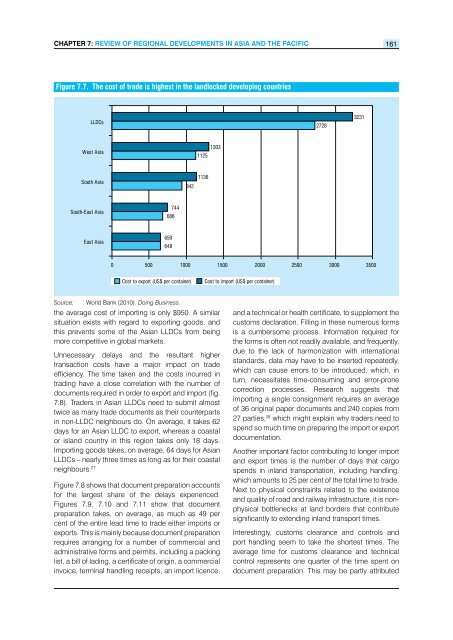Review of Maritime Transport 2010 - Unctad
Review of Maritime Transport 2010 - Unctad
Review of Maritime Transport 2010 - Unctad
You also want an ePaper? Increase the reach of your titles
YUMPU automatically turns print PDFs into web optimized ePapers that Google loves.
CHapteR 7: <strong>Review</strong> <strong>of</strong> ReGionaL DeveLopMents in asia anD tHe paCifiC 161<br />
Figure 7.7. The cost <strong>of</strong> trade is highest in the landlocked developing countries<br />
LLDCs<br />
West Asia<br />
South Asia<br />
South-East Asia<br />
East Asia<br />
744<br />
686<br />
650<br />
648<br />
Source: World Bank (<strong>2010</strong>). Doing Business.<br />
the average cost <strong>of</strong> importing is only $950. A similar<br />
situation exists with regard to exporting goods, and<br />
this prevents some <strong>of</strong> the Asian LLDCs from being<br />
more competitive in global markets.<br />
Unnecessary delays and the resultant higher<br />
transaction costs have a major impact on trade<br />
efficiency. The time taken and the costs incurred in<br />
trading have a close correlation with the number <strong>of</strong><br />
documents required in order to export and import (fig.<br />
7.8). Traders in Asian LLDCs need to submit almost<br />
twice as many trade documents as their counterparts<br />
in non-LLDC neighbours do. On average, it takes 62<br />
days for an Asian LLDC to export, whereas a coastal<br />
or island country in this region takes only 18 days.<br />
Importing goods takes, on average, 64 days for Asian<br />
LLDCs – nearly three times as long as for their coastal<br />
neighbours. 27<br />
Figure 7.8 shows that document preparation accounts<br />
for the largest share <strong>of</strong> the delays experienced.<br />
Figures 7.9, 7.10 and 7.11 show that document<br />
preparation takes, on average, as much as 49 per<br />
cent <strong>of</strong> the entire lead time to trade either imports or<br />
exports. This is mainly because document preparation<br />
requires arranging for a number <strong>of</strong> commercial and<br />
administrative forms and permits, including a packing<br />
list, a bill <strong>of</strong> lading, a certificate <strong>of</strong> origin, a commercial<br />
invoice, terminal handling receipts, an import licence,<br />
942<br />
1303<br />
1125<br />
1136<br />
0 500 1000 1500 2000 2500 3000 3500<br />
Cost to export (US$ per container) Cost to import (US$ per container)<br />
2728<br />
3231<br />
and a technical or health certificate, to supplement the<br />
customs declaration. Filling in these numerous forms<br />
is a cumbersome process. Information required for<br />
the forms is <strong>of</strong>ten not readily available, and frequently,<br />
due to the lack <strong>of</strong> harmonization with international<br />
standards, data may have to be inserted repeatedly,<br />
which can cause errors to be introduced, which, in<br />
turn, necessitates time-consuming and error-prone<br />
correction processes. Research suggests that<br />
importing a single consignment requires an average<br />
<strong>of</strong> 36 original paper documents and 240 copies from<br />
27 parties, 28 which might explain why traders need to<br />
spend so much time on preparing the import or export<br />
documentation.<br />
Another important factor contributing to longer import<br />
and export times is the number <strong>of</strong> days that cargo<br />
spends in inland transportation, including handling,<br />
which amounts to 25 per cent <strong>of</strong> the total time to trade.<br />
Next to physical constraints related to the existence<br />
and quality <strong>of</strong> road and railway infrastructure, it is nonphysical<br />
bottlenecks at land borders that contribute<br />
significantly to extending inland transport times.<br />
Interestingly, customs clearance and controls and<br />
port handling seem to take the shortest times. The<br />
average time for customs clearance and technical<br />
control represents one quarter <strong>of</strong> the time spent on<br />
document preparation. This may be partly attributed

















